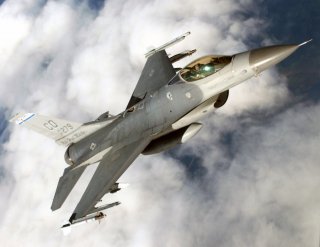Ongoing Upgrades are Keeping the F-16 Fighter Flying High
Current Air Force F-16s have flown roughly 6,000-7,000 thousand flight hours, en route to the original plan to fly the planes out to 8,000 hours.
Here's What You Need To Remember: The new F-16 also uses a high degree of increased onboard automation to free up pilot focus and workload. By automatically performing a range of important procedural functions independently, a pilot is then freed up to focus more intently on other mission-critical tasks.
How has the F-16 fighter stayed in action for so long?
The question has many answers, perhaps above and beyond the simple fact that the airframe itself is likely still viable by virtue of ongoing upgrades and Service Life Extension Programs (SLEP).
Current Air Force F-16s have flown roughly 6,000-7,000 thousand flight hours, en route to the original plan to fly the planes out to 8,000 hours. Now, however, the Air Force plan is to fly the jets all the way out to 12,000 hours, given the extent of the combat upgrades. The SLEP program consists of twelve structural modifications and an existing Time Compliance Technical Order.
In addition, the Air Force is upgrading 372 F-16 aircraft from the existing mechanically scanned radar (APG-68) to the same radar that is on the F-35, an Active Electronically Scanned Array, The new AESA radar nearly doubles the range of existing radar systems, enabling much more substantial detection and targeting capability.
One indication of a way the F-16 may succeed in extending its service life and live for years to come can be found through the Lockheed-India collaborative effort to engineer a new, massively upgraded and improved F-16 variant, called the F-21.
The F-21 incorporates several specific-to-India technologies, according to Lockheed developers. Some of these technologies include an advanced, Northrop built APG-83 Active Electronically Scanned Array, Electronic Warfare systems and Triple Missile Launcher Adapters “allowing the F-21 to carry 40-percent more air-to-air weapons than previous F-16 designs.”
The F-21 also uses a U.S. Navy-built advanced Infrared Search and Track (IRST) targeting technology. IRST is used extensively in U.S. Navy Super Hornet F-18 upgrades. Navy officials have described the IRST system is a passive, long-range sensor that searches for and detects infrared emissions. IRST is designed to simultaneously track multiple targets and provide a highly effective air-to-air targeting capability, even when encountering advanced threats equipped with radar-jamming technology, Navy developers explained.
The IRST technology was specifically engineered with a mind to the fast-changing electromagnetic warfare environment and the realization that potential future adversaries are far more likely to contest U.S. dominance in these areas. IRST also provides the Super Hornet an alternate air-to-air targeting system in a high threat electronic attack environment, developers explained. The IRST technology, designed by Boeing and Lockheed Martin, is designed to search for heat signals over long distances, providing the aircraft with key targeting information. The IRST system—which has been tested on F/A-18s, is passive and therefore harder to detect than some radar technologies which give off radiation, developers said.
The new F-16 also uses a high degree of increased onboard automation to free up pilot focus and workload. By automatically performing a range of important procedural functions independently, a pilot is then freed up to focus more intently on other mission-critical tasks.
Kris Osborn is the defense editor for the National Interest. Osborn previously served at the Pentagon as a Highly Qualified Expert with the Office of the Assistant Secretary of the Army—Acquisition, Logistics & Technology. Osborn has also worked as an anchor and on-air military specialist at national TV networks. He has appeared as a guest military expert on Fox News, MSNBC, The Military Channel, and The History Channel. He also has a Masters Degree in Comparative Literature from Columbia University. This article first appeared earlier this year.
Image: Wikipedia.

